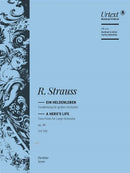| 作曲者 | Richard Strauss (1864-1949)・リヒャルト・シュトラウス |
| タイトル | Ein Heldenleben = A Hero's Life (Score) |
| サブタイトル | Tone Poem for Large Orchestra – Urtext |
| 出版社 | Breitkopf & Härtel・ブライトコプフ |
| 楽器編成 | Orchestra |
| 楽器編成(詳細) | picc.3.4(4.cor ang).Eb-clar.2.B-clar.3.dble bsn – 8.5.3.T-tuba.B-tuba – 2hp – timp – perc – str |
| 品番 | BH9790004216484 |
| 校訂者 | Nick Pfefferkorn |
| 形状 | 176 ページ・27 x 36 cm・938 g・ソフトカバー |
| 演奏時間 | 45分 |
| 出版年 | 2025年 |
| 出版番号 | PB 5711 |
| ISMN | 979-0-004-21648-4 |
| その他 | Urtext |
| サンプル | https://issuu.com/breitkopf/docs/pb_5711_strauss_ein_heldenleben?fr=sZDc0NDg0NzU1MzE |
・First Urtext edition since the the first print
・Evaluation of all avaiblable sources (e.g. autograph score as well as the corrected printed scores by Walter Seifert and Clemens Krauss)
・For the first time ever, the first version of the ending is included
・Due to sophisticated alternatives in the parts, both endings are performable
“The others spit venom and bile, mainly because they believed that the rather ugly descriptions of the naysayers and opponents were meant to be about themselves.” This comment, as well as his performance instructions for the woodwinds, “very sharp and pointed, rattling, hissing” (at that time still titled The Hero’s Adversary), were intended to emphasize once again how little Strauss cared about the chatter of his critics. The genesis of A Hero's Life is closely linked to that of its antagonist, the tragicomic figure of Don Quixote. Strauss originally intended both works to be performed together, i.e. in the same concert.
“ … the audience doesn't believe that you can close forte,” a visitor is said to have remarked over breakfast, commenting on the quiet fading away of the solo violin and horn. And young Richard is said to have scribbled a new ending on a piece of paper between toast and tea. “A state funeral,” Strauss joked at the dress rehearsal of the new ending we know today.
Breitkopf & Härtel's Urtext edition not only evaluates all known sources (including the autograph and the score, corrected by Walter Seiffert), but also makes the original “pianissimo ending,” which was discarded shortly before the premiere, accessible and performable again.



